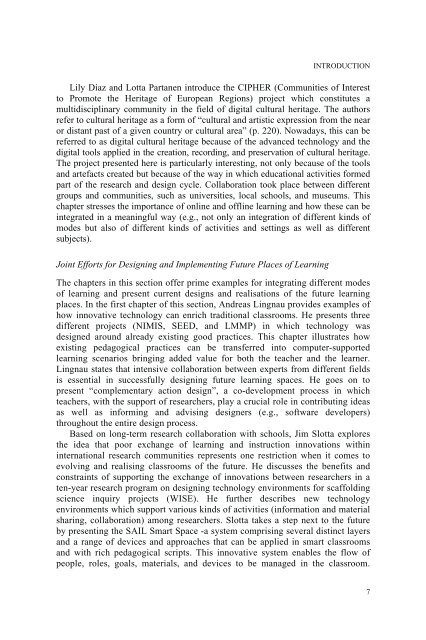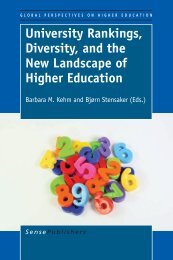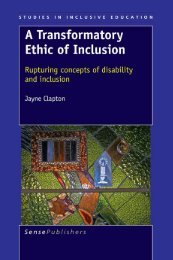Classroom of the Future - Sense Publishers
Classroom of the Future - Sense Publishers
Classroom of the Future - Sense Publishers
You also want an ePaper? Increase the reach of your titles
YUMPU automatically turns print PDFs into web optimized ePapers that Google loves.
INTRODUCTION<br />
Lily Díaz and Lotta Partanen introduce <strong>the</strong> CIPHER (Communities <strong>of</strong> Interest<br />
to Promote <strong>the</strong> Heritage <strong>of</strong> European Regions) project which constitutes a<br />
multidisciplinary community in <strong>the</strong> field <strong>of</strong> digital cultural heritage. The authors<br />
refer to cultural heritage as a form <strong>of</strong> “cultural and artistic expression from <strong>the</strong> near<br />
or distant past <strong>of</strong> a given country or cultural area” (p. 220). Nowadays, this can be<br />
referred to as digital cultural heritage because <strong>of</strong> <strong>the</strong> advanced technology and <strong>the</strong><br />
digital tools applied in <strong>the</strong> creation, recording, and preservation <strong>of</strong> cultural heritage.<br />
The project presented here is particularly interesting, not only because <strong>of</strong> <strong>the</strong> tools<br />
and artefacts created but because <strong>of</strong> <strong>the</strong> way in which educational activities formed<br />
part <strong>of</strong> <strong>the</strong> research and design cycle. Collaboration took place between different<br />
groups and communities, such as universities, local schools, and museums. This<br />
chapter stresses <strong>the</strong> importance <strong>of</strong> online and <strong>of</strong>fline learning and how <strong>the</strong>se can be<br />
integrated in a meaningful way (e.g., not only an integration <strong>of</strong> different kinds <strong>of</strong><br />
modes but also <strong>of</strong> different kinds <strong>of</strong> activities and settings as well as different<br />
subjects).<br />
Joint Efforts for Designing and Implementing <strong>Future</strong> Places <strong>of</strong> Learning<br />
The chapters in this section <strong>of</strong>fer prime examples for integrating different modes<br />
<strong>of</strong> learning and present current designs and realisations <strong>of</strong> <strong>the</strong> future learning<br />
places. In <strong>the</strong> first chapter <strong>of</strong> this section, Andreas Lingnau provides examples <strong>of</strong><br />
how innovative technology can enrich traditional classrooms. He presents three<br />
different projects (NIMIS, SEED, and LMMP) in which technology was<br />
designed around already existing good practices. This chapter illustrates how<br />
existing pedagogical practices can be transferred into computer-supported<br />
learning scenarios bringing added value for both <strong>the</strong> teacher and <strong>the</strong> learner.<br />
Lingnau states that intensive collaboration between experts from different fields<br />
is essential in successfully designing future learning spaces. He goes on to<br />
present “complementary action design”, a co-development process in which<br />
teachers, with <strong>the</strong> support <strong>of</strong> researchers, play a crucial role in contributing ideas<br />
as well as informing and advising designers (e.g., s<strong>of</strong>tware developers)<br />
throughout <strong>the</strong> entire design process.<br />
Based on long-term research collaboration with schools, Jim Slotta explores<br />
<strong>the</strong> idea that poor exchange <strong>of</strong> learning and instruction innovations within<br />
international research communities represents one restriction when it comes to<br />
evolving and realising classrooms <strong>of</strong> <strong>the</strong> future. He discusses <strong>the</strong> benefits and<br />
constraints <strong>of</strong> supporting <strong>the</strong> exchange <strong>of</strong> innovations between researchers in a<br />
ten-year research program on designing technology environments for scaffolding<br />
science inquiry projects (WISE). He fur<strong>the</strong>r describes new technology<br />
environments which support various kinds <strong>of</strong> activities (information and material<br />
sharing, collaboration) among researchers. Slotta takes a step next to <strong>the</strong> future<br />
by presenting <strong>the</strong> SAIL Smart Space -a system comprising several distinct layers<br />
and a range <strong>of</strong> devices and approaches that can be applied in smart classrooms<br />
and with rich pedagogical scripts. This innovative system enables <strong>the</strong> flow <strong>of</strong><br />
people, roles, goals, materials, and devices to be managed in <strong>the</strong> classroom.<br />
7














